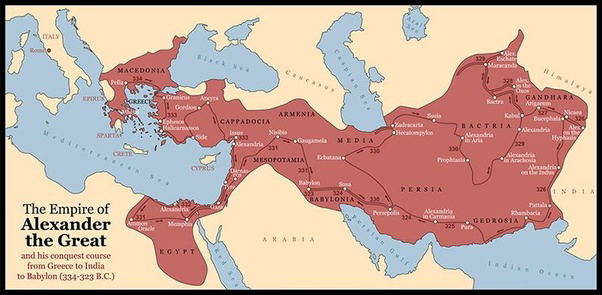Macedonian empire: The empire of Alexander the great
The Macedonian Empire, also known as the Empire of Alexander the Great, was one of the largest empires in ancient history. It spread Greek culture, language, and influence across three continents and reshaped the ancient world. Here's a detailed breakdown of everything you need to know:
🔹 ORIGINS OF MACEDONIA
Location:
Macedon (or Macedonia) was a kingdom located in northern Greece, bordered by the Greek city-states to the south and the Balkan tribes to the north.
Capital: Pella
Early Kings:
King Amyntas I (c. 540–498 BCE) is one of the earliest known kings.
King Philip II (r. 359–336 BCE) transformed Macedonia from a weak kingdom into a powerful military state.
🔹 PHILIP II (382–336 BCE)
Achievements:
Reformed the army: Introduced the phalanx formation, used longer spears (sarissas), and trained a professional standing army.
Conquered much of Greece after the Battle of Chaeronea (338 BCE).
Planned to invade the Persian Empire, but was assassinated before doing so.
🔹 ALEXANDER THE GREAT (356–323 BCE)
Rise to Power:
Became king at age 20 after Philip II's assassination.
Educated by Aristotle, and inherited a powerful, disciplined army.
Conquests (334–323 BCE):
Alexander launched one of the most ambitious military campaigns in history.
Major Campaigns:
Battle of Granicus (334 BCE) – Defeated Persian satraps in Asia Minor.
Battle of Issus (333 BCE) – Defeated Persian King Darius III.
Siege of Tyre (332 BCE) – Conquered the powerful city of Tyre.
Conquest of Egypt (332 BCE) – Founded Alexandria.
Battle of Gaugamela (331 BCE) – Final defeat of Darius III.
Babylon, Susa, Persepolis – Took the Persian capitals.
March into India:
Battle of Hydaspes (326 BCE) – Defeated King Porus.
His troops mutinied at the Hyphasis River, refusing to go further east.
Death:
Died in 323 BCE in Babylon, possibly due to fever, poison, or other causes.
Had no clear successor – said to have left his empire “to the strongest.”
🔹 THE EMPIRE AFTER ALEXANDER
The Diadochi (Successor Wars):
His generals (called Diadochi) fought over the empire, leading to its fragmentation.
Division of the Empire:
By around 275 BCE, the empire had split into major Hellenistic kingdoms:
Ptolemaic Kingdom (Egypt) – Ruled by Ptolemy I, lasted until Cleopatra VII.
Seleucid Empire (Persia & Mesopotamia) – Founded by Seleucus I.
Antigonid Kingdom (Macedonia & Greece) – Founded by Antigonus I.
🔹 CULTURE & LEGACY
Hellenization:
The spread of Greek language, art, architecture, religion, and philosophy across the empire.
Cities like Alexandria became centers of learning and culture.
Influence:
Set the stage for the Roman Empire, which absorbed and preserved much of Greek culture.
Inspired military leaders for centuries (e.g., Napoleon, Caesar).
Fusion of Greek, Egyptian, Persian, and Indian cultures (e.g., Greco-Buddhism in India).
🔹 TIMELINE SUMMARY
| Year | Event |
|---|---|
| 359 BCE | Philip II becomes king |
| 338 BCE | Battle of Chaeronea – Greece falls to Macedon |
| 336 BCE | Alexander becomes king |
| 334–323 BCE | Alexander’s conquests |
| 323 BCE | Alexander dies – empire begins to fragment |
| 275 BCE | Final division into Hellenistic kingdoms |
🔹 MAP (Description)
The empire stretched from:
Greece in the west
Egypt in the south
Persia (Iran) and Mesopotamia (Iraq)
India in the east (Punjab region)




Comments
Post a Comment